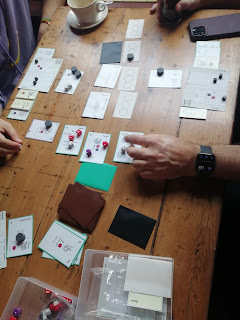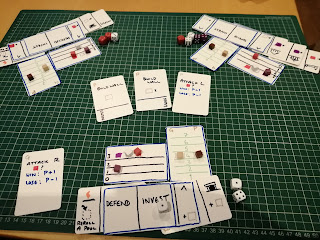It has been a while since I last made it into the monthly Sunday playtest session in London, but this month the stars aligned, so I got on a train, with my City States Co-op prototype in the bag. I tend to allow plenty of time to travel, so I have time to have a walk around, sit in a coffee shop, or whatever when I get there. This time it was a nice day and I felt like a walk, so I went down the road, across Vauxhall Bridge, along Albert Embankment, returning to the North over Lambeth Bridge, and then back along Millbank. A pleasant enough walk, and a change from my usual environs.
Anyway, at the Jugged Hare, the venue for the meetup, there were only four of us at first, joined by a fifth after we had got started on a game, but this new arrival was happy to observe and was able to helpfully contribute to the discussion at the end. The first game we played was my prototype, run as a three player game with me observing, which was pretty much my dream situation for the session.
So how did the test go? Well, I was already a little uncomfortable about the early phases of the first round or two, where players all contribute dice to central pools associated with challenge cards. My initial discomfort was that in the first turn or two this is effectively not a choice, though one of the players did say that it was cool to have some aspects of the first turn or two acting as a training phase which expands later. The problem was that in practice, this whole part of the round throughout the game just felt fussy and the players didn't really feel that it added any interesting decisions; one of the players couldn't engage with this at all and pretty much zoned out.
We had some discussion about stuff related to this and one of the players was asserting that actually if the cooperative element was all about distributing challenge cards between players and you own your own dice, that should just do the job.
This is potentially painful to me as one of the central points of the initial discussion that lead to this prototype's form was about sharing dice, and the thought that unrolled dice are a resource that are full of potential that may or may not pay off as you hope. I really liked that thought. It might be that I could find an expression of that concept in this game, but right now, I'm going to explore the feedback and observations from this playtest, scrap the whole dice sharing part of the game, and then adjust the rest of things to fit with that.
Another random comment came from as we were setting up. I have two decks of challenge cards, one of which is nominally "harder" than the other. The idea I was working with was that the aim of the game is to empty the tougher deck, and you can choose which deck to draw cards from (this was actually an idea that was a bit spur of the moment) each time you draw. One of the players said something about the first deck being the "engine" and the other being the objectives. This was partially true, and tickled me, and I think I might lean into that some more: deck 1 could mostly provide capabilities and deck 2 mostly problems.
The difficulty curve was also off, but I'm not really worried about that yet. Actually the game ended up with a very narrow defeat for the players, which is cool, BUT most of the real pressure hit early on, and the rest of the game was trying to make up for that. This could be great for some groups, but I'd rather we had a general ramp up (with a few comparative lulls). It's all a matter of tuning, once the main structure is more solid, but the new approach to the two decks should help control this.
So, there are plenty of problems with this game, but I felt that the flow of the game was mostly looking pretty good and I have a feeling that the game might be "a thing", that is probably worth some more time. I think I know what to do for the next iteration now...








